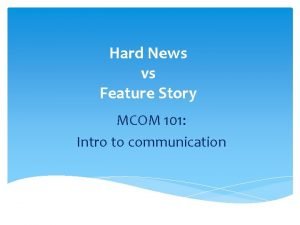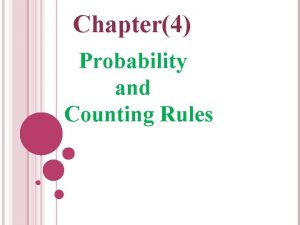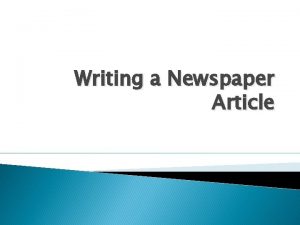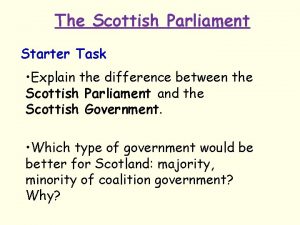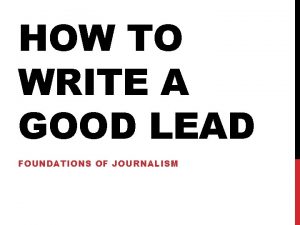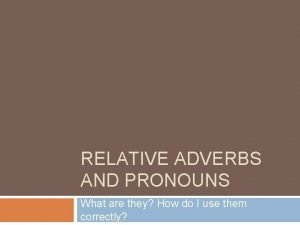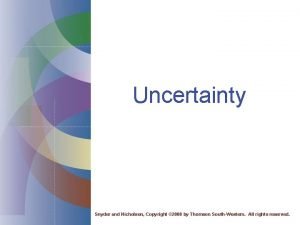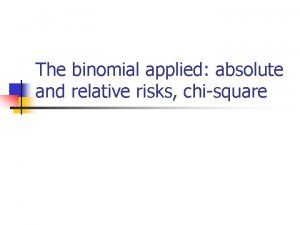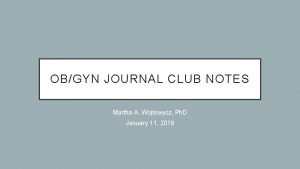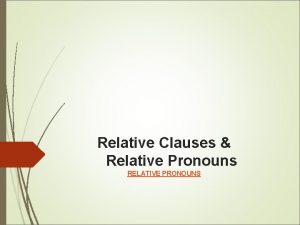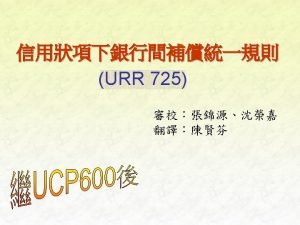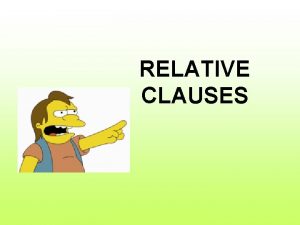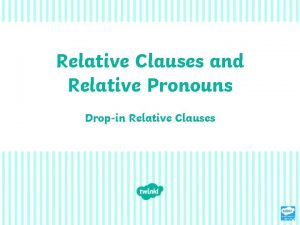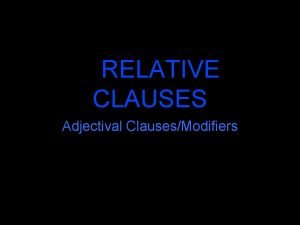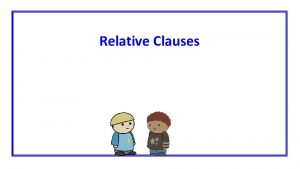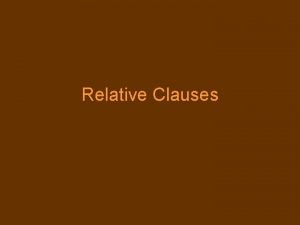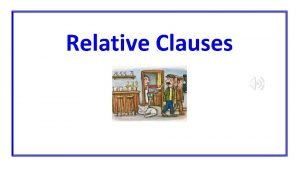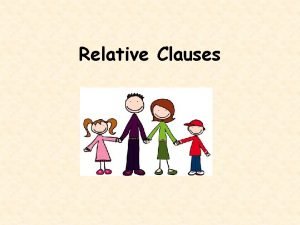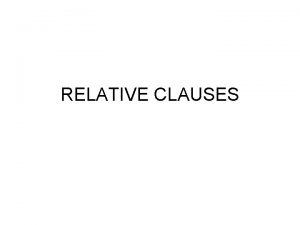Risk and Relative Risk Suppose a news article

























- Slides: 25

Risk and Relative Risk

Suppose a news article claimed that drinking coffee doubled your risk of developing a certain disease. Assume the statistic was based on legitimate, wellconducted research. Does this statistic provide any information on your actual risk? What additional information would you want about the risk before deciding whether to quit drinking coffee?

A study classified pregnant women according to whether they smoked and whether they were able to get pregnant during the first cycle in which they tried to do so. What do you think is the question of interest? Attempt to answer it. Here are the results:

A recent study estimated that the “relative risk” of a woman developing lung cancer if she smoked was 27. 9. What do you think is meant by the term relative risk?

Students in a statistics class were asked whether they preferred an in-class or a take-home final exam and were then categorized as to whether they had received an A on the midterm. Of the 25 A students, 10 preferred a take-home exam, whereas of the 50 non-A students, 30 preferred a take-home exam. How would you display these data in a table?

Displaying Variables: Contingency Tables • Count the number of individuals who fall into each combination of categories. • Present counts in table = contingency table. • Row = explanatory variable. • Column = response variable.

Example: Aspirin and Heart Attacks Rows = explanatory variable = aspirin or placebo Columns = response variable = heart attack or no heart attack Contingency Table with explanatory as row variable, response as column variable, four cells. Open file Heart. Attack. xls

Conditional Percentages and Rates Question of Interest: Do the percentages in each category of the response variable change when the explanatory variable changes? Meaning does taking aspirin change the chances of having a heart attack? Find the percentage of the aspirin group who had a heart attack and the percentage of the placebo group who had a heart attack. Note: When the percentages are very small it is common to express as a rate per 1000 (or 100, 000, etc)

Conditional Percentages and Rates To Find the Conditional (Row) Percentages Aspirin Group: Percentage who had heart attacks = 104/11, 037 = 0. 0094 or 0. 94% Rate per 1000 = 9. 4 (multiply the original rate person by 1000) Placebo Group: Percentage who had heart attacks = 189/11, 034 = 0. 0171 or 1. 71% Rate per 1000 = 17. 1 • Percentage: rate per 100, written with % sign • Rate: the number of heart attacks person (or per 1000 people or per 10, 000 or per 100, 000 depending on the size of the rate)

Conditional Percentages and Rates Example: Percentage and Rate Added

Different Expressions: Risk, Probability, and Odds Percentage with trait = (number with trait/total) expressed as % Proportion or rate with trait = number with trait/total Probability of having trait = number with trait/total or expressed as a percent Risk of having trait = number with trait/total Odds of having trait = (number with trait/number without trait)

Relative Risk, Increased Risk, and Odds A population contains 1000 individuals, of which 400 carry the gene for a disease. Equivalent ways to express this proportion: • Forty percent (40%) of all individuals carry the gene. • The proportion who carry the gene is 0. 40. • The rate is. 4 person or 40 per 100 people. • The probability that someone carries the gene is. 40 or 40%. • The risk of carrying the gene is 0. 40. • The odds of carrying the gene are 400 to 600 (or 2 to 3, or 2/3 to 1).

Baseline Risk and Relative Risk The significance of a risk is hard to evaluate on its own. One way to better understand the effect of the explanatory variable is to calculate the relative risk. Relative Risk: of outcome for two categories of explanatory variable is ratio of risks for each category. Often a risk is compared to the baseline risk. Baseline Risk: risk without treatment or changed behavior The baseline risk can be difficult to find. If placebo included, baseline risk = risk for placebo group.

Meaning of Relative Risk The meaning of the relative risk is how many times more likely the outcome is with the explanatory variable than without it. If the relative risk is greater than 1, the risk is greater with the explanatory variable. If the relative risk is less than 1, the risk is lower with the variable than without.

Relative Risk of Having a Heart Attack if taking Aspirin What is the relative risk of having a heart attack if you take aspirin? What is the meaning of Relative Risk?

Relative Risk of Having a Heart Attack if taking Aspirin Relative risk = risk of heart attack with aspirin / risk without = 9. 4/17. 1 =. 55 Meaning of Relative Risk of having a heart attack if you are taking aspirin is. 55 times as great as the risk of having a heart attack if not taking aspirin. One is less likely to suffer if taking aspirin.

Relative Risk of Developing Breast Cancer What question do you think the researchers were trying to answer? What is the risk of breast cancer if a woman had her first child at age 25 or older? What is the risk of breast cancer if a woman had her first child before age 25? What is the relative risk?

Relative Risk of Developing Breast Cancer • Risk for women having firstquestion child at 25 If your is: or older 31/1628 = to 0. 0190 What is the relative risk of A=compared B? • Risk for women having first child before 25 = 0. 0143 1) Find the risk =of 65/4540 A • Relative risk = 0. 0190/0. 0143 1. 33 of B 2) Find the=risk 3) Relative risk = (risk of A) / (risk of B) Meaning of Relative Risk shouldbreast word cancer your answer this who way: had Risk of You developing for women The first risk child of A is timesisas 1. 33 great as the risk of their at _____ 25 or older times as great as. B. the risk for women who had their first child before 25.

Meaning of Relative Risk A relative risk that is greater than 1. 0 shows that there is an increased risk in the group in question. A relative risk that is equal to 1. 0 shows that there is equal risk in both groups. A relative risk that is less than 1. 0 indicates that there is a lower risk in the group in question. Note: Relative risk is expressed in decimal form.

Increased Risk = (relative risk – 1. 0) Example: Increased Risk of Breast Cancer • Relative risk = 1. 33 • Increased risk = 1. 33 - 1 = 0. 33 or 33% There is a 33% increase in the risk of breast cancer for women who have a child after 25 compared to women who have a child before the age of 25. Note: Increased risk and decreased risk are expressed in percent form.

Decreased Risk = (1. 0 - relative risk) For the heart attack example: • Relative risk =. 55. • Decreased risk: 1 -. 55 =. 45 = 45% There is a 45% decrease in risk of heart attack when taking aspirin.

Relative Risk Researchers often report relative risks adjusted to account for confounding variables. Example: Suppose relative risk for getting cancer for those with high-fat vs low-fat diet is 1. 3, adjusted for age and smoking status. => Relative risk applies (approx. ) for two groups of individuals of same age and smoking status, where one group has high-fat diet and other has low-fat diet.

Misleading Statistics about Risk Common ways the media misrepresent statistics about risk: 1. The baseline risk is missing. 2. The time period of the risk is not identified. 3. The reported risk is not necessarily your risk.

Missing Baseline Risk “Evidence of new cancer-beer connection” Sacramento Bee, March 8, 1984, p. A 1 • Reported men who drank 500 ounces or more of beer a month (about 16 ounces a day) were three times more likely to develop cancer of the rectum than nondrinkers. • Is this enough information to change your lifestyle (or at least be concerned about your current) if you were a man who drank 500 ounces of beer a month?

Missing Baseline Risk • A common misrepresentation of relative or increased risk is not including the baseline risk. • Need baseline risk to make an informed decision. • Less concerned if chances go from 1 in 100, 000 to 3 in 100, 000 compared to 1 in 10 to 3 in 10. • If you knew that the baseline risk in this study was about 1 in 180, what would you do?
 Attributable risk formula
Attributable risk formula Population attributable risk
Population attributable risk Difference between news report and feature article
Difference between news report and feature article How to calculate relative risk
How to calculate relative risk Absolute risk vs relative risk
Absolute risk vs relative risk Hard news vs soft news
Hard news vs soft news Chapter 4 probability and counting rules
Chapter 4 probability and counting rules No news _____ good news.
No news _____ good news. Sample of news article
Sample of news article News article starters
News article starters Magazine article structure
Magazine article structure News article about globalization
News article about globalization Straight news article
Straight news article News article example
News article example The anatomy of a newspaper
The anatomy of a newspaper Relative clauses and relative pronouns stage 15
Relative clauses and relative pronouns stage 15 The person who phoned me last night is my teacher.
The person who phoned me last night is my teacher. Relative pronouns and relative adverbs
Relative pronouns and relative adverbs Market risk assessment
Market risk assessment Conditional relative frequency table
Conditional relative frequency table How to calculate relative risk
How to calculate relative risk Contoh relative risk
Contoh relative risk Relative risk calculation
Relative risk calculation How to find relative risk
How to find relative risk Interpreting relative risk
Interpreting relative risk Relative risk interpretation
Relative risk interpretation


